Business Management Report: Sustainable Strategies and CSR Approaches
VerifiedAdded on 2022/12/17
|14
|4816
|1
Report
AI Summary
This report examines sustainable business strategies and management, focusing on ethical and sustainable operations, strategic planning, and corporate social responsibility (CSR). It analyzes the approaches of micro, small and medium-sized enterprises (SMEs), and corporate businesses to CSR, comparing their similarities, differences, and methods for measuring success. The report uses Tesco as a case study, detailing their initiatives to reduce plastic use, limit overproduction, promote sustainable diets, and engage in charity partnerships. Additionally, the report includes a reflective section on key skills development, demonstrating understanding of management theories, strategic planning, and self-management. The report uses references to support the analysis and findings.
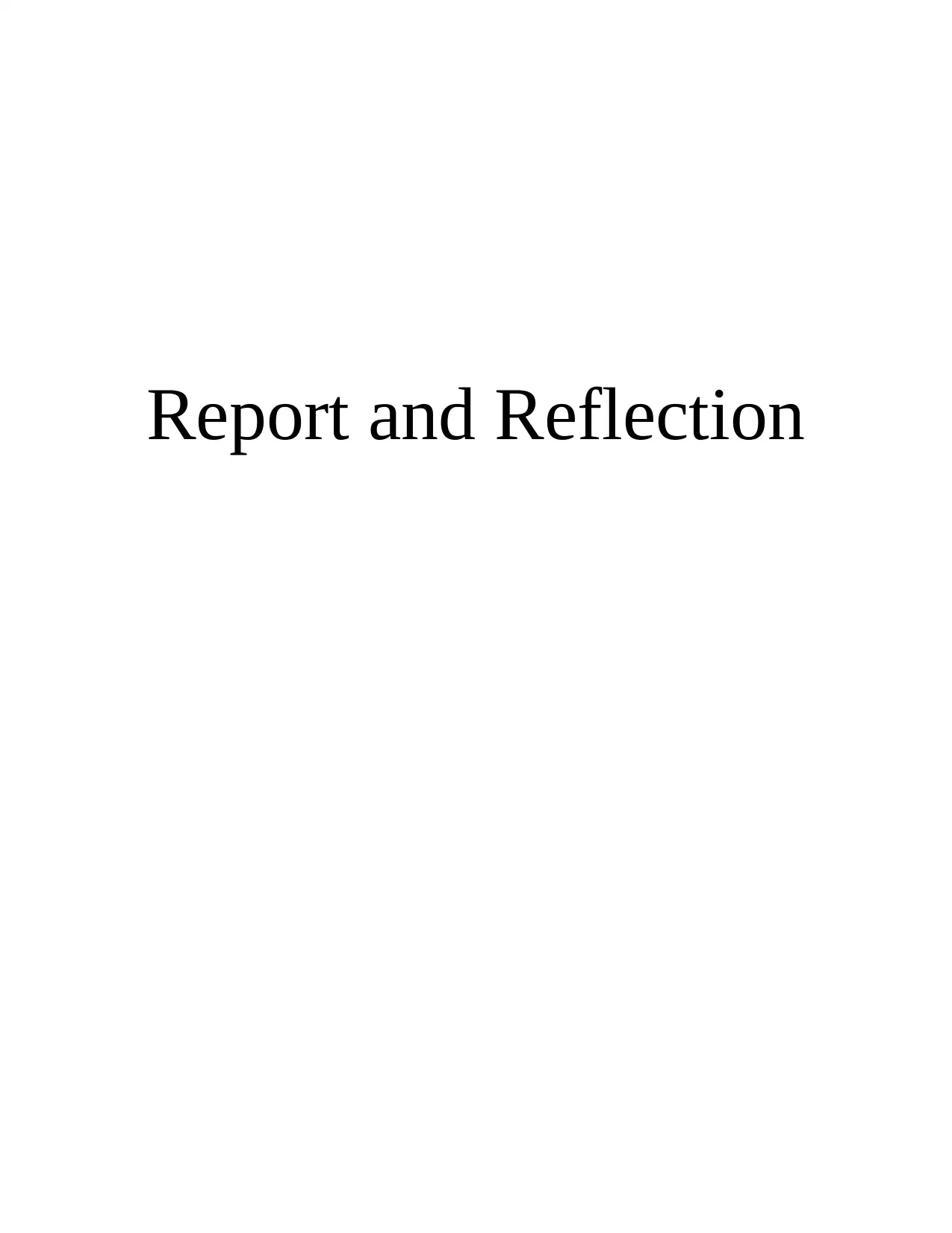
Report and Reflection
Paraphrase This Document
Need a fresh take? Get an instant paraphrase of this document with our AI Paraphraser
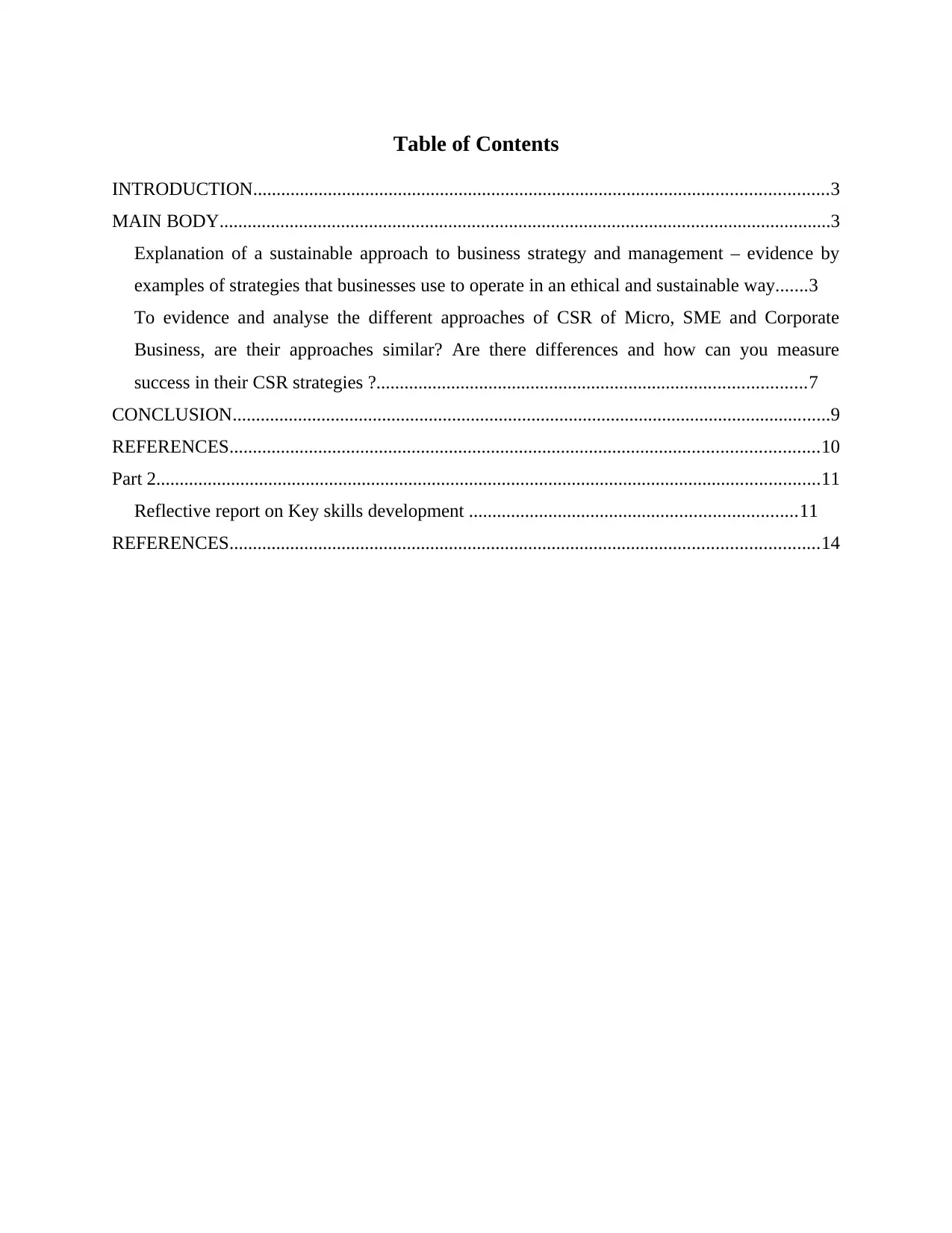
Table of Contents
INTRODUCTION...........................................................................................................................3
MAIN BODY...................................................................................................................................3
Explanation of a sustainable approach to business strategy and management – evidence by
examples of strategies that businesses use to operate in an ethical and sustainable way.......3
To evidence and analyse the different approaches of CSR of Micro, SME and Corporate
Business, are their approaches similar? Are there differences and how can you measure
success in their CSR strategies ?............................................................................................7
CONCLUSION................................................................................................................................9
REFERENCES..............................................................................................................................10
Part 2..............................................................................................................................................11
Reflective report on Key skills development ......................................................................11
REFERENCES..............................................................................................................................14
INTRODUCTION...........................................................................................................................3
MAIN BODY...................................................................................................................................3
Explanation of a sustainable approach to business strategy and management – evidence by
examples of strategies that businesses use to operate in an ethical and sustainable way.......3
To evidence and analyse the different approaches of CSR of Micro, SME and Corporate
Business, are their approaches similar? Are there differences and how can you measure
success in their CSR strategies ?............................................................................................7
CONCLUSION................................................................................................................................9
REFERENCES..............................................................................................................................10
Part 2..............................................................................................................................................11
Reflective report on Key skills development ......................................................................11
REFERENCES..............................................................................................................................14
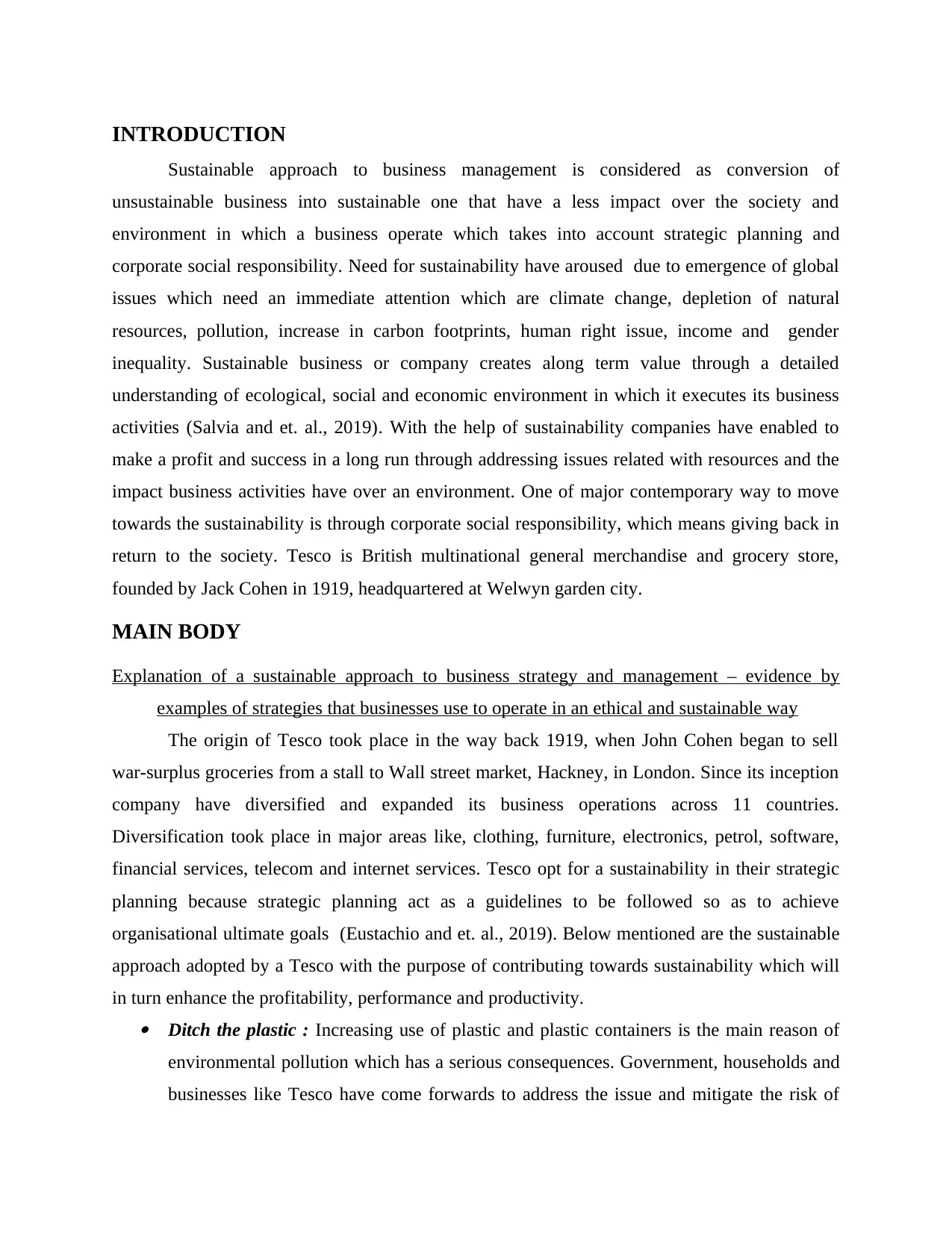
INTRODUCTION
Sustainable approach to business management is considered as conversion of
unsustainable business into sustainable one that have a less impact over the society and
environment in which a business operate which takes into account strategic planning and
corporate social responsibility. Need for sustainability have aroused due to emergence of global
issues which need an immediate attention which are climate change, depletion of natural
resources, pollution, increase in carbon footprints, human right issue, income and gender
inequality. Sustainable business or company creates along term value through a detailed
understanding of ecological, social and economic environment in which it executes its business
activities (Salvia and et. al., 2019). With the help of sustainability companies have enabled to
make a profit and success in a long run through addressing issues related with resources and the
impact business activities have over an environment. One of major contemporary way to move
towards the sustainability is through corporate social responsibility, which means giving back in
return to the society. Tesco is British multinational general merchandise and grocery store,
founded by Jack Cohen in 1919, headquartered at Welwyn garden city.
MAIN BODY
Explanation of a sustainable approach to business strategy and management – evidence by
examples of strategies that businesses use to operate in an ethical and sustainable way
The origin of Tesco took place in the way back 1919, when John Cohen began to sell
war-surplus groceries from a stall to Wall street market, Hackney, in London. Since its inception
company have diversified and expanded its business operations across 11 countries.
Diversification took place in major areas like, clothing, furniture, electronics, petrol, software,
financial services, telecom and internet services. Tesco opt for a sustainability in their strategic
planning because strategic planning act as a guidelines to be followed so as to achieve
organisational ultimate goals (Eustachio and et. al., 2019). Below mentioned are the sustainable
approach adopted by a Tesco with the purpose of contributing towards sustainability which will
in turn enhance the profitability, performance and productivity. Ditch the plastic : Increasing use of plastic and plastic containers is the main reason of
environmental pollution which has a serious consequences. Government, households and
businesses like Tesco have come forwards to address the issue and mitigate the risk of
Sustainable approach to business management is considered as conversion of
unsustainable business into sustainable one that have a less impact over the society and
environment in which a business operate which takes into account strategic planning and
corporate social responsibility. Need for sustainability have aroused due to emergence of global
issues which need an immediate attention which are climate change, depletion of natural
resources, pollution, increase in carbon footprints, human right issue, income and gender
inequality. Sustainable business or company creates along term value through a detailed
understanding of ecological, social and economic environment in which it executes its business
activities (Salvia and et. al., 2019). With the help of sustainability companies have enabled to
make a profit and success in a long run through addressing issues related with resources and the
impact business activities have over an environment. One of major contemporary way to move
towards the sustainability is through corporate social responsibility, which means giving back in
return to the society. Tesco is British multinational general merchandise and grocery store,
founded by Jack Cohen in 1919, headquartered at Welwyn garden city.
MAIN BODY
Explanation of a sustainable approach to business strategy and management – evidence by
examples of strategies that businesses use to operate in an ethical and sustainable way
The origin of Tesco took place in the way back 1919, when John Cohen began to sell
war-surplus groceries from a stall to Wall street market, Hackney, in London. Since its inception
company have diversified and expanded its business operations across 11 countries.
Diversification took place in major areas like, clothing, furniture, electronics, petrol, software,
financial services, telecom and internet services. Tesco opt for a sustainability in their strategic
planning because strategic planning act as a guidelines to be followed so as to achieve
organisational ultimate goals (Eustachio and et. al., 2019). Below mentioned are the sustainable
approach adopted by a Tesco with the purpose of contributing towards sustainability which will
in turn enhance the profitability, performance and productivity. Ditch the plastic : Increasing use of plastic and plastic containers is the main reason of
environmental pollution which has a serious consequences. Government, households and
businesses like Tesco have come forwards to address the issue and mitigate the risk of
⊘ This is a preview!⊘
Do you want full access?
Subscribe today to unlock all pages.

Trusted by 1+ million students worldwide
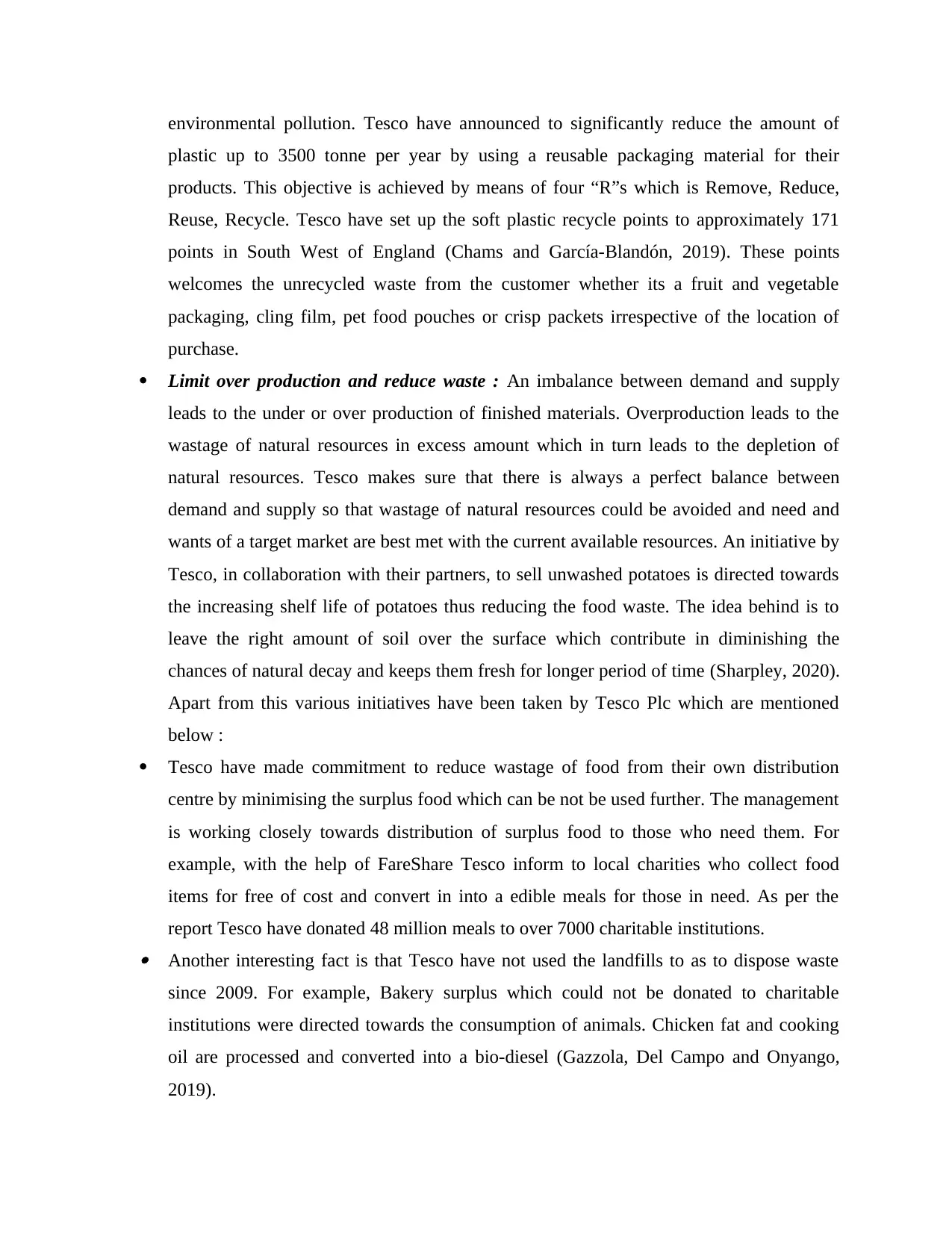
environmental pollution. Tesco have announced to significantly reduce the amount of
plastic up to 3500 tonne per year by using a reusable packaging material for their
products. This objective is achieved by means of four “R”s which is Remove, Reduce,
Reuse, Recycle. Tesco have set up the soft plastic recycle points to approximately 171
points in South West of England (Chams and García-Blandón, 2019). These points
welcomes the unrecycled waste from the customer whether its a fruit and vegetable
packaging, cling film, pet food pouches or crisp packets irrespective of the location of
purchase.
Limit over production and reduce waste : An imbalance between demand and supply
leads to the under or over production of finished materials. Overproduction leads to the
wastage of natural resources in excess amount which in turn leads to the depletion of
natural resources. Tesco makes sure that there is always a perfect balance between
demand and supply so that wastage of natural resources could be avoided and need and
wants of a target market are best met with the current available resources. An initiative by
Tesco, in collaboration with their partners, to sell unwashed potatoes is directed towards
the increasing shelf life of potatoes thus reducing the food waste. The idea behind is to
leave the right amount of soil over the surface which contribute in diminishing the
chances of natural decay and keeps them fresh for longer period of time (Sharpley, 2020).
Apart from this various initiatives have been taken by Tesco Plc which are mentioned
below :
Tesco have made commitment to reduce wastage of food from their own distribution
centre by minimising the surplus food which can be not be used further. The management
is working closely towards distribution of surplus food to those who need them. For
example, with the help of FareShare Tesco inform to local charities who collect food
items for free of cost and convert in into a edible meals for those in need. As per the
report Tesco have donated 48 million meals to over 7000 charitable institutions. Another interesting fact is that Tesco have not used the landfills to as to dispose waste
since 2009. For example, Bakery surplus which could not be donated to charitable
institutions were directed towards the consumption of animals. Chicken fat and cooking
oil are processed and converted into a bio-diesel (Gazzola, Del Campo and Onyango,
2019).
plastic up to 3500 tonne per year by using a reusable packaging material for their
products. This objective is achieved by means of four “R”s which is Remove, Reduce,
Reuse, Recycle. Tesco have set up the soft plastic recycle points to approximately 171
points in South West of England (Chams and García-Blandón, 2019). These points
welcomes the unrecycled waste from the customer whether its a fruit and vegetable
packaging, cling film, pet food pouches or crisp packets irrespective of the location of
purchase.
Limit over production and reduce waste : An imbalance between demand and supply
leads to the under or over production of finished materials. Overproduction leads to the
wastage of natural resources in excess amount which in turn leads to the depletion of
natural resources. Tesco makes sure that there is always a perfect balance between
demand and supply so that wastage of natural resources could be avoided and need and
wants of a target market are best met with the current available resources. An initiative by
Tesco, in collaboration with their partners, to sell unwashed potatoes is directed towards
the increasing shelf life of potatoes thus reducing the food waste. The idea behind is to
leave the right amount of soil over the surface which contribute in diminishing the
chances of natural decay and keeps them fresh for longer period of time (Sharpley, 2020).
Apart from this various initiatives have been taken by Tesco Plc which are mentioned
below :
Tesco have made commitment to reduce wastage of food from their own distribution
centre by minimising the surplus food which can be not be used further. The management
is working closely towards distribution of surplus food to those who need them. For
example, with the help of FareShare Tesco inform to local charities who collect food
items for free of cost and convert in into a edible meals for those in need. As per the
report Tesco have donated 48 million meals to over 7000 charitable institutions. Another interesting fact is that Tesco have not used the landfills to as to dispose waste
since 2009. For example, Bakery surplus which could not be donated to charitable
institutions were directed towards the consumption of animals. Chicken fat and cooking
oil are processed and converted into a bio-diesel (Gazzola, Del Campo and Onyango,
2019).
Paraphrase This Document
Need a fresh take? Get an instant paraphrase of this document with our AI Paraphraser
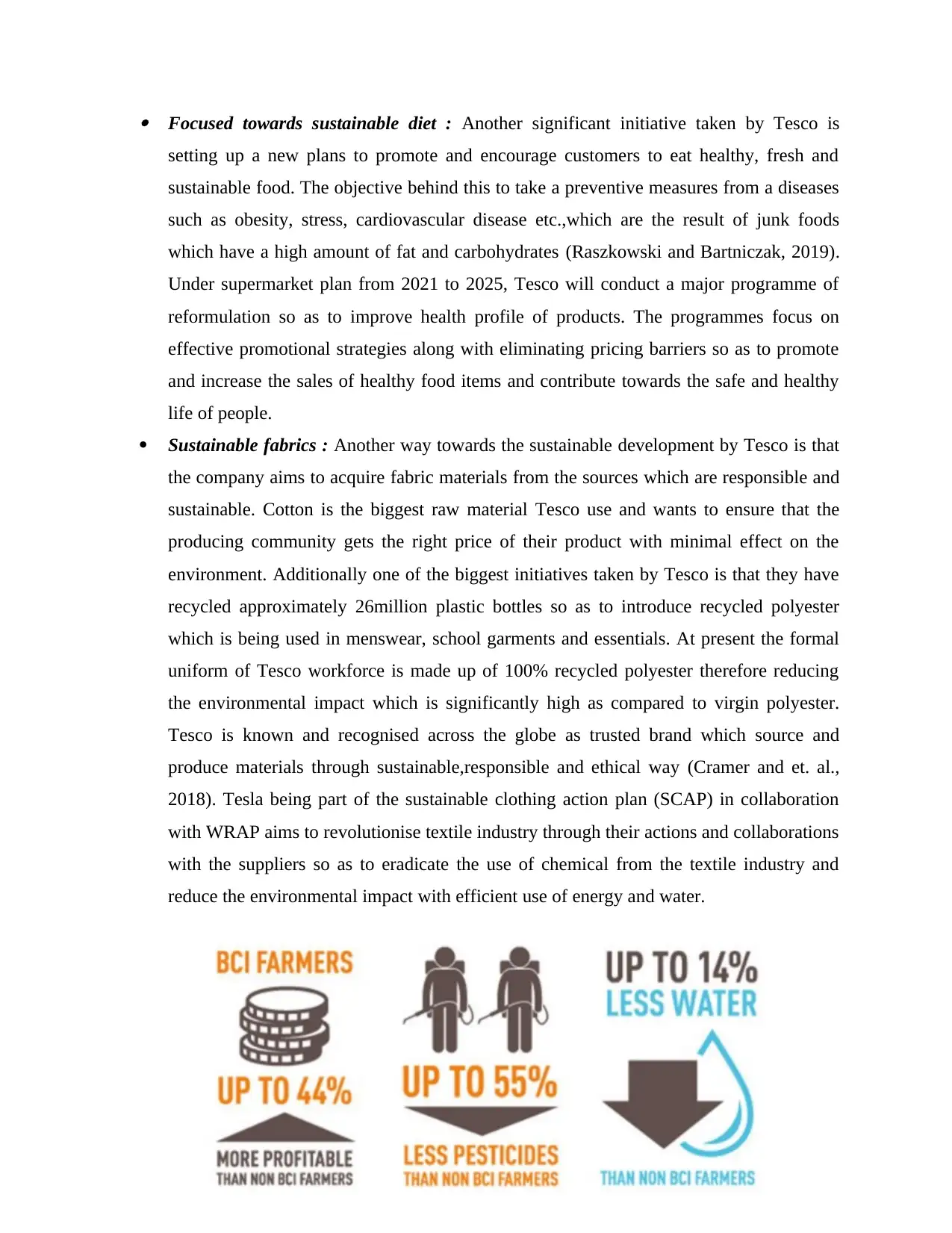
Focused towards sustainable diet : Another significant initiative taken by Tesco is
setting up a new plans to promote and encourage customers to eat healthy, fresh and
sustainable food. The objective behind this to take a preventive measures from a diseases
such as obesity, stress, cardiovascular disease etc.,which are the result of junk foods
which have a high amount of fat and carbohydrates (Raszkowski and Bartniczak, 2019).
Under supermarket plan from 2021 to 2025, Tesco will conduct a major programme of
reformulation so as to improve health profile of products. The programmes focus on
effective promotional strategies along with eliminating pricing barriers so as to promote
and increase the sales of healthy food items and contribute towards the safe and healthy
life of people.
Sustainable fabrics : Another way towards the sustainable development by Tesco is that
the company aims to acquire fabric materials from the sources which are responsible and
sustainable. Cotton is the biggest raw material Tesco use and wants to ensure that the
producing community gets the right price of their product with minimal effect on the
environment. Additionally one of the biggest initiatives taken by Tesco is that they have
recycled approximately 26million plastic bottles so as to introduce recycled polyester
which is being used in menswear, school garments and essentials. At present the formal
uniform of Tesco workforce is made up of 100% recycled polyester therefore reducing
the environmental impact which is significantly high as compared to virgin polyester.
Tesco is known and recognised across the globe as trusted brand which source and
produce materials through sustainable,responsible and ethical way (Cramer and et. al.,
2018). Tesla being part of the sustainable clothing action plan (SCAP) in collaboration
with WRAP aims to revolutionise textile industry through their actions and collaborations
with the suppliers so as to eradicate the use of chemical from the textile industry and
reduce the environmental impact with efficient use of energy and water.
setting up a new plans to promote and encourage customers to eat healthy, fresh and
sustainable food. The objective behind this to take a preventive measures from a diseases
such as obesity, stress, cardiovascular disease etc.,which are the result of junk foods
which have a high amount of fat and carbohydrates (Raszkowski and Bartniczak, 2019).
Under supermarket plan from 2021 to 2025, Tesco will conduct a major programme of
reformulation so as to improve health profile of products. The programmes focus on
effective promotional strategies along with eliminating pricing barriers so as to promote
and increase the sales of healthy food items and contribute towards the safe and healthy
life of people.
Sustainable fabrics : Another way towards the sustainable development by Tesco is that
the company aims to acquire fabric materials from the sources which are responsible and
sustainable. Cotton is the biggest raw material Tesco use and wants to ensure that the
producing community gets the right price of their product with minimal effect on the
environment. Additionally one of the biggest initiatives taken by Tesco is that they have
recycled approximately 26million plastic bottles so as to introduce recycled polyester
which is being used in menswear, school garments and essentials. At present the formal
uniform of Tesco workforce is made up of 100% recycled polyester therefore reducing
the environmental impact which is significantly high as compared to virgin polyester.
Tesco is known and recognised across the globe as trusted brand which source and
produce materials through sustainable,responsible and ethical way (Cramer and et. al.,
2018). Tesla being part of the sustainable clothing action plan (SCAP) in collaboration
with WRAP aims to revolutionise textile industry through their actions and collaborations
with the suppliers so as to eradicate the use of chemical from the textile industry and
reduce the environmental impact with efficient use of energy and water.
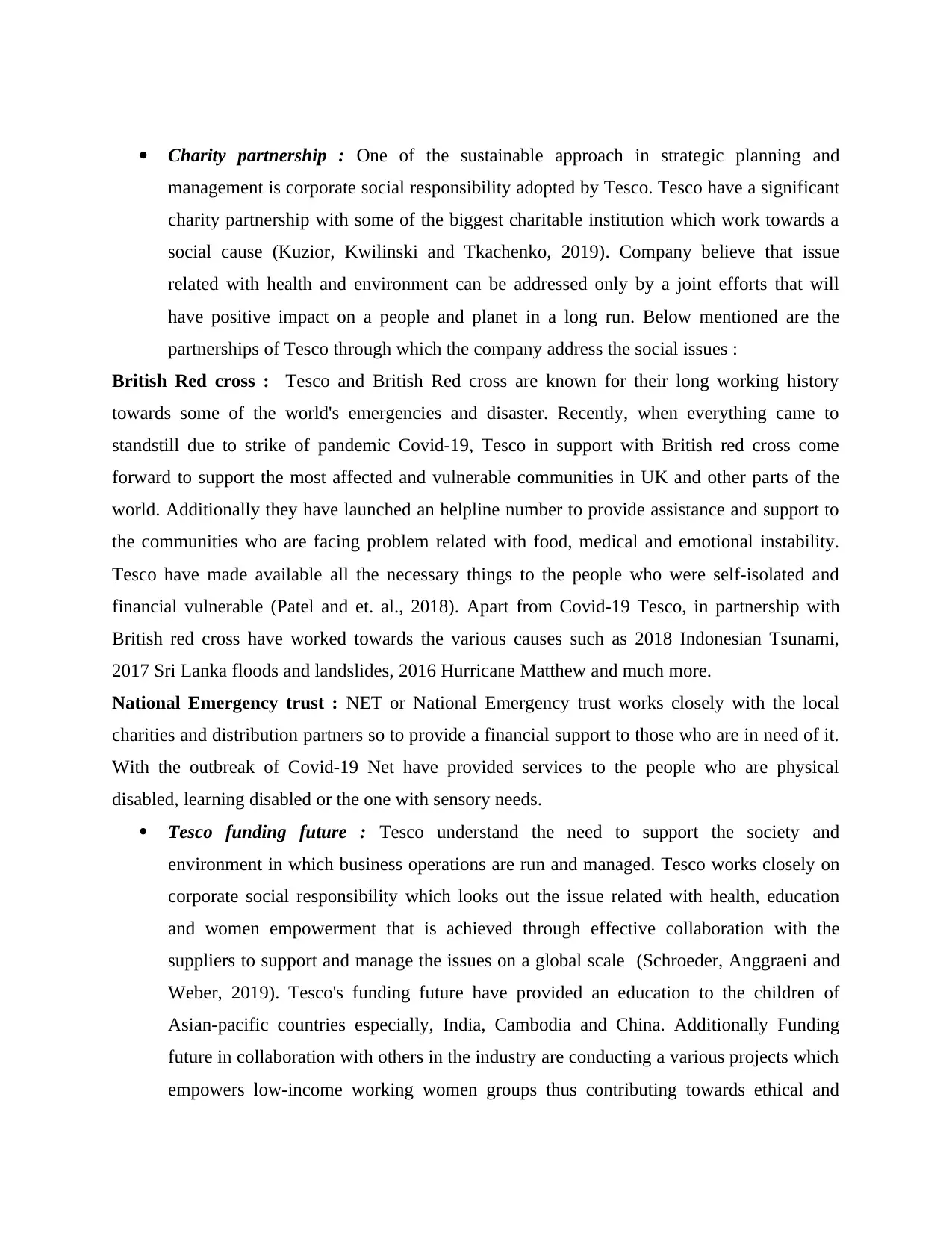
Charity partnership : One of the sustainable approach in strategic planning and
management is corporate social responsibility adopted by Tesco. Tesco have a significant
charity partnership with some of the biggest charitable institution which work towards a
social cause (Kuzior, Kwilinski and Tkachenko, 2019). Company believe that issue
related with health and environment can be addressed only by a joint efforts that will
have positive impact on a people and planet in a long run. Below mentioned are the
partnerships of Tesco through which the company address the social issues :
British Red cross : Tesco and British Red cross are known for their long working history
towards some of the world's emergencies and disaster. Recently, when everything came to
standstill due to strike of pandemic Covid-19, Tesco in support with British red cross come
forward to support the most affected and vulnerable communities in UK and other parts of the
world. Additionally they have launched an helpline number to provide assistance and support to
the communities who are facing problem related with food, medical and emotional instability.
Tesco have made available all the necessary things to the people who were self-isolated and
financial vulnerable (Patel and et. al., 2018). Apart from Covid-19 Tesco, in partnership with
British red cross have worked towards the various causes such as 2018 Indonesian Tsunami,
2017 Sri Lanka floods and landslides, 2016 Hurricane Matthew and much more.
National Emergency trust : NET or National Emergency trust works closely with the local
charities and distribution partners so to provide a financial support to those who are in need of it.
With the outbreak of Covid-19 Net have provided services to the people who are physical
disabled, learning disabled or the one with sensory needs.
Tesco funding future : Tesco understand the need to support the society and
environment in which business operations are run and managed. Tesco works closely on
corporate social responsibility which looks out the issue related with health, education
and women empowerment that is achieved through effective collaboration with the
suppliers to support and manage the issues on a global scale (Schroeder, Anggraeni and
Weber, 2019). Tesco's funding future have provided an education to the children of
Asian-pacific countries especially, India, Cambodia and China. Additionally Funding
future in collaboration with others in the industry are conducting a various projects which
empowers low-income working women groups thus contributing towards ethical and
management is corporate social responsibility adopted by Tesco. Tesco have a significant
charity partnership with some of the biggest charitable institution which work towards a
social cause (Kuzior, Kwilinski and Tkachenko, 2019). Company believe that issue
related with health and environment can be addressed only by a joint efforts that will
have positive impact on a people and planet in a long run. Below mentioned are the
partnerships of Tesco through which the company address the social issues :
British Red cross : Tesco and British Red cross are known for their long working history
towards some of the world's emergencies and disaster. Recently, when everything came to
standstill due to strike of pandemic Covid-19, Tesco in support with British red cross come
forward to support the most affected and vulnerable communities in UK and other parts of the
world. Additionally they have launched an helpline number to provide assistance and support to
the communities who are facing problem related with food, medical and emotional instability.
Tesco have made available all the necessary things to the people who were self-isolated and
financial vulnerable (Patel and et. al., 2018). Apart from Covid-19 Tesco, in partnership with
British red cross have worked towards the various causes such as 2018 Indonesian Tsunami,
2017 Sri Lanka floods and landslides, 2016 Hurricane Matthew and much more.
National Emergency trust : NET or National Emergency trust works closely with the local
charities and distribution partners so to provide a financial support to those who are in need of it.
With the outbreak of Covid-19 Net have provided services to the people who are physical
disabled, learning disabled or the one with sensory needs.
Tesco funding future : Tesco understand the need to support the society and
environment in which business operations are run and managed. Tesco works closely on
corporate social responsibility which looks out the issue related with health, education
and women empowerment that is achieved through effective collaboration with the
suppliers to support and manage the issues on a global scale (Schroeder, Anggraeni and
Weber, 2019). Tesco's funding future have provided an education to the children of
Asian-pacific countries especially, India, Cambodia and China. Additionally Funding
future in collaboration with others in the industry are conducting a various projects which
empowers low-income working women groups thus contributing towards ethical and
⊘ This is a preview!⊘
Do you want full access?
Subscribe today to unlock all pages.

Trusted by 1+ million students worldwide
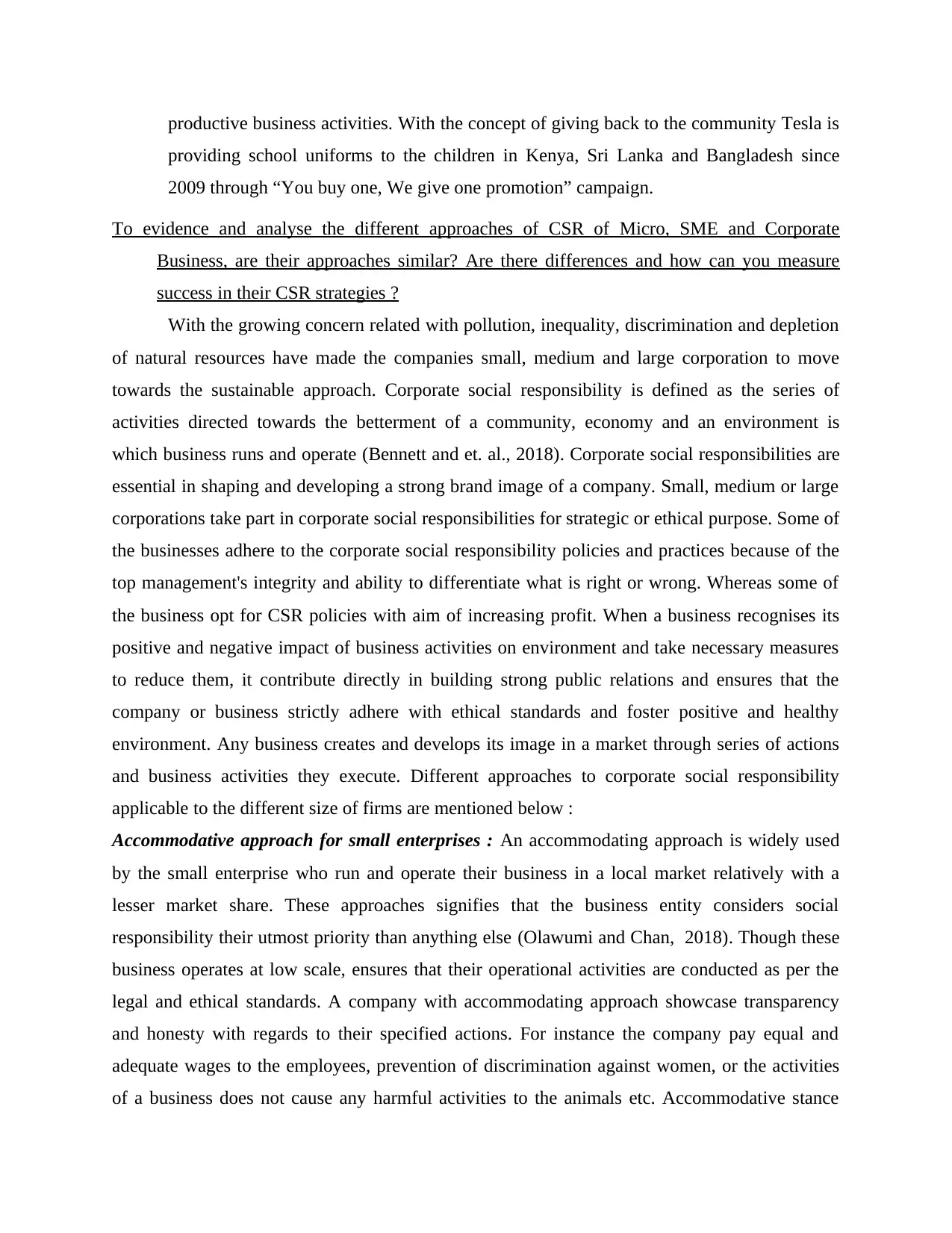
productive business activities. With the concept of giving back to the community Tesla is
providing school uniforms to the children in Kenya, Sri Lanka and Bangladesh since
2009 through “You buy one, We give one promotion” campaign.
To evidence and analyse the different approaches of CSR of Micro, SME and Corporate
Business, are their approaches similar? Are there differences and how can you measure
success in their CSR strategies ?
With the growing concern related with pollution, inequality, discrimination and depletion
of natural resources have made the companies small, medium and large corporation to move
towards the sustainable approach. Corporate social responsibility is defined as the series of
activities directed towards the betterment of a community, economy and an environment is
which business runs and operate (Bennett and et. al., 2018). Corporate social responsibilities are
essential in shaping and developing a strong brand image of a company. Small, medium or large
corporations take part in corporate social responsibilities for strategic or ethical purpose. Some of
the businesses adhere to the corporate social responsibility policies and practices because of the
top management's integrity and ability to differentiate what is right or wrong. Whereas some of
the business opt for CSR policies with aim of increasing profit. When a business recognises its
positive and negative impact of business activities on environment and take necessary measures
to reduce them, it contribute directly in building strong public relations and ensures that the
company or business strictly adhere with ethical standards and foster positive and healthy
environment. Any business creates and develops its image in a market through series of actions
and business activities they execute. Different approaches to corporate social responsibility
applicable to the different size of firms are mentioned below :
Accommodative approach for small enterprises : An accommodating approach is widely used
by the small enterprise who run and operate their business in a local market relatively with a
lesser market share. These approaches signifies that the business entity considers social
responsibility their utmost priority than anything else (Olawumi and Chan, 2018). Though these
business operates at low scale, ensures that their operational activities are conducted as per the
legal and ethical standards. A company with accommodating approach showcase transparency
and honesty with regards to their specified actions. For instance the company pay equal and
adequate wages to the employees, prevention of discrimination against women, or the activities
of a business does not cause any harmful activities to the animals etc. Accommodative stance
providing school uniforms to the children in Kenya, Sri Lanka and Bangladesh since
2009 through “You buy one, We give one promotion” campaign.
To evidence and analyse the different approaches of CSR of Micro, SME and Corporate
Business, are their approaches similar? Are there differences and how can you measure
success in their CSR strategies ?
With the growing concern related with pollution, inequality, discrimination and depletion
of natural resources have made the companies small, medium and large corporation to move
towards the sustainable approach. Corporate social responsibility is defined as the series of
activities directed towards the betterment of a community, economy and an environment is
which business runs and operate (Bennett and et. al., 2018). Corporate social responsibilities are
essential in shaping and developing a strong brand image of a company. Small, medium or large
corporations take part in corporate social responsibilities for strategic or ethical purpose. Some of
the businesses adhere to the corporate social responsibility policies and practices because of the
top management's integrity and ability to differentiate what is right or wrong. Whereas some of
the business opt for CSR policies with aim of increasing profit. When a business recognises its
positive and negative impact of business activities on environment and take necessary measures
to reduce them, it contribute directly in building strong public relations and ensures that the
company or business strictly adhere with ethical standards and foster positive and healthy
environment. Any business creates and develops its image in a market through series of actions
and business activities they execute. Different approaches to corporate social responsibility
applicable to the different size of firms are mentioned below :
Accommodative approach for small enterprises : An accommodating approach is widely used
by the small enterprise who run and operate their business in a local market relatively with a
lesser market share. These approaches signifies that the business entity considers social
responsibility their utmost priority than anything else (Olawumi and Chan, 2018). Though these
business operates at low scale, ensures that their operational activities are conducted as per the
legal and ethical standards. A company with accommodating approach showcase transparency
and honesty with regards to their specified actions. For instance the company pay equal and
adequate wages to the employees, prevention of discrimination against women, or the activities
of a business does not cause any harmful activities to the animals etc. Accommodative stance
Paraphrase This Document
Need a fresh take? Get an instant paraphrase of this document with our AI Paraphraser
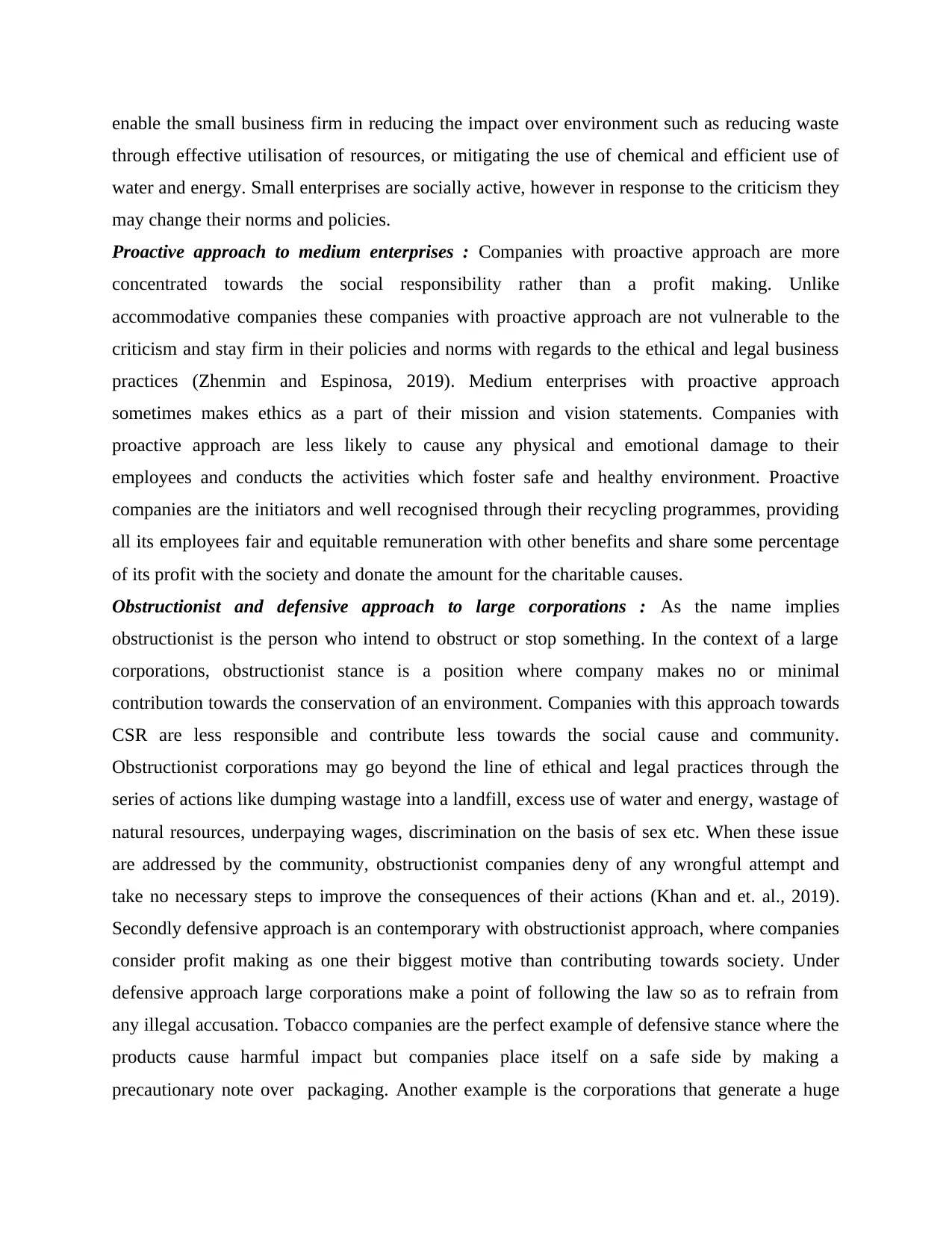
enable the small business firm in reducing the impact over environment such as reducing waste
through effective utilisation of resources, or mitigating the use of chemical and efficient use of
water and energy. Small enterprises are socially active, however in response to the criticism they
may change their norms and policies.
Proactive approach to medium enterprises : Companies with proactive approach are more
concentrated towards the social responsibility rather than a profit making. Unlike
accommodative companies these companies with proactive approach are not vulnerable to the
criticism and stay firm in their policies and norms with regards to the ethical and legal business
practices (Zhenmin and Espinosa, 2019). Medium enterprises with proactive approach
sometimes makes ethics as a part of their mission and vision statements. Companies with
proactive approach are less likely to cause any physical and emotional damage to their
employees and conducts the activities which foster safe and healthy environment. Proactive
companies are the initiators and well recognised through their recycling programmes, providing
all its employees fair and equitable remuneration with other benefits and share some percentage
of its profit with the society and donate the amount for the charitable causes.
Obstructionist and defensive approach to large corporations : As the name implies
obstructionist is the person who intend to obstruct or stop something. In the context of a large
corporations, obstructionist stance is a position where company makes no or minimal
contribution towards the conservation of an environment. Companies with this approach towards
CSR are less responsible and contribute less towards the social cause and community.
Obstructionist corporations may go beyond the line of ethical and legal practices through the
series of actions like dumping wastage into a landfill, excess use of water and energy, wastage of
natural resources, underpaying wages, discrimination on the basis of sex etc. When these issue
are addressed by the community, obstructionist companies deny of any wrongful attempt and
take no necessary steps to improve the consequences of their actions (Khan and et. al., 2019).
Secondly defensive approach is an contemporary with obstructionist approach, where companies
consider profit making as one their biggest motive than contributing towards society. Under
defensive approach large corporations make a point of following the law so as to refrain from
any illegal accusation. Tobacco companies are the perfect example of defensive stance where the
products cause harmful impact but companies place itself on a safe side by making a
precautionary note over packaging. Another example is the corporations that generate a huge
through effective utilisation of resources, or mitigating the use of chemical and efficient use of
water and energy. Small enterprises are socially active, however in response to the criticism they
may change their norms and policies.
Proactive approach to medium enterprises : Companies with proactive approach are more
concentrated towards the social responsibility rather than a profit making. Unlike
accommodative companies these companies with proactive approach are not vulnerable to the
criticism and stay firm in their policies and norms with regards to the ethical and legal business
practices (Zhenmin and Espinosa, 2019). Medium enterprises with proactive approach
sometimes makes ethics as a part of their mission and vision statements. Companies with
proactive approach are less likely to cause any physical and emotional damage to their
employees and conducts the activities which foster safe and healthy environment. Proactive
companies are the initiators and well recognised through their recycling programmes, providing
all its employees fair and equitable remuneration with other benefits and share some percentage
of its profit with the society and donate the amount for the charitable causes.
Obstructionist and defensive approach to large corporations : As the name implies
obstructionist is the person who intend to obstruct or stop something. In the context of a large
corporations, obstructionist stance is a position where company makes no or minimal
contribution towards the conservation of an environment. Companies with this approach towards
CSR are less responsible and contribute less towards the social cause and community.
Obstructionist corporations may go beyond the line of ethical and legal practices through the
series of actions like dumping wastage into a landfill, excess use of water and energy, wastage of
natural resources, underpaying wages, discrimination on the basis of sex etc. When these issue
are addressed by the community, obstructionist companies deny of any wrongful attempt and
take no necessary steps to improve the consequences of their actions (Khan and et. al., 2019).
Secondly defensive approach is an contemporary with obstructionist approach, where companies
consider profit making as one their biggest motive than contributing towards society. Under
defensive approach large corporations make a point of following the law so as to refrain from
any illegal accusation. Tobacco companies are the perfect example of defensive stance where the
products cause harmful impact but companies place itself on a safe side by making a
precautionary note over packaging. Another example is the corporations that generate a huge
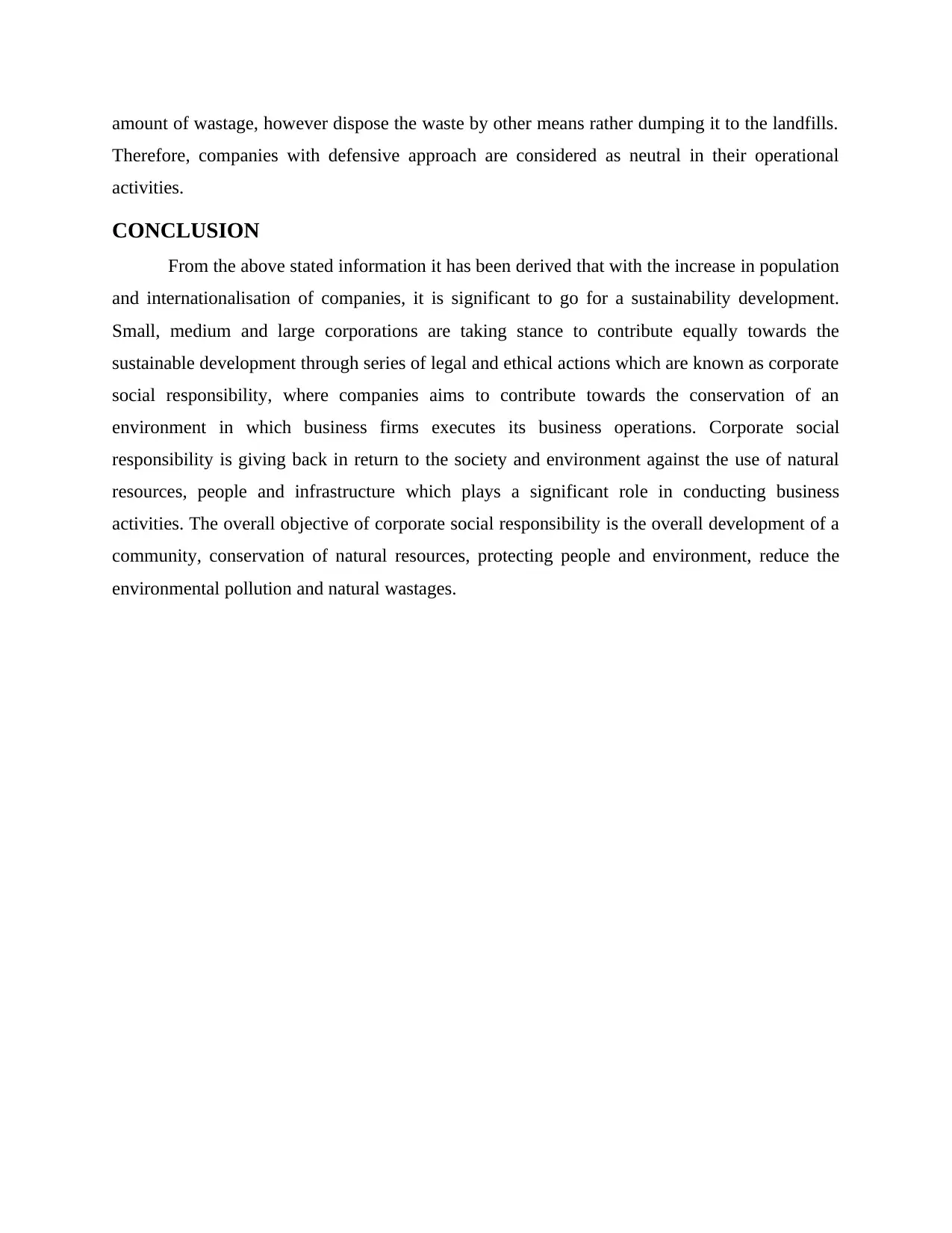
amount of wastage, however dispose the waste by other means rather dumping it to the landfills.
Therefore, companies with defensive approach are considered as neutral in their operational
activities.
CONCLUSION
From the above stated information it has been derived that with the increase in population
and internationalisation of companies, it is significant to go for a sustainability development.
Small, medium and large corporations are taking stance to contribute equally towards the
sustainable development through series of legal and ethical actions which are known as corporate
social responsibility, where companies aims to contribute towards the conservation of an
environment in which business firms executes its business operations. Corporate social
responsibility is giving back in return to the society and environment against the use of natural
resources, people and infrastructure which plays a significant role in conducting business
activities. The overall objective of corporate social responsibility is the overall development of a
community, conservation of natural resources, protecting people and environment, reduce the
environmental pollution and natural wastages.
Therefore, companies with defensive approach are considered as neutral in their operational
activities.
CONCLUSION
From the above stated information it has been derived that with the increase in population
and internationalisation of companies, it is significant to go for a sustainability development.
Small, medium and large corporations are taking stance to contribute equally towards the
sustainable development through series of legal and ethical actions which are known as corporate
social responsibility, where companies aims to contribute towards the conservation of an
environment in which business firms executes its business operations. Corporate social
responsibility is giving back in return to the society and environment against the use of natural
resources, people and infrastructure which plays a significant role in conducting business
activities. The overall objective of corporate social responsibility is the overall development of a
community, conservation of natural resources, protecting people and environment, reduce the
environmental pollution and natural wastages.
⊘ This is a preview!⊘
Do you want full access?
Subscribe today to unlock all pages.

Trusted by 1+ million students worldwide
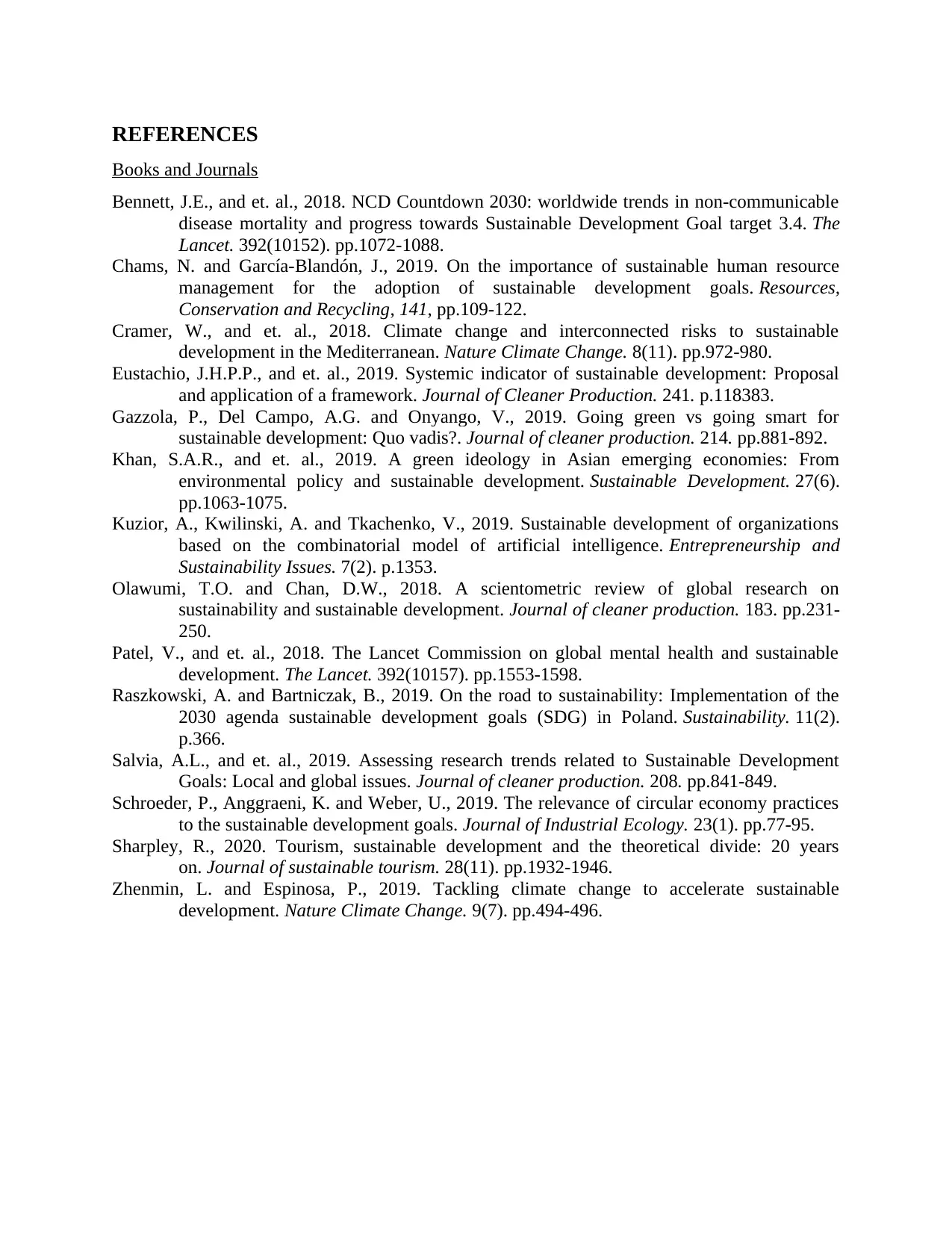
REFERENCES
Books and Journals
Bennett, J.E., and et. al., 2018. NCD Countdown 2030: worldwide trends in non-communicable
disease mortality and progress towards Sustainable Development Goal target 3.4. The
Lancet. 392(10152). pp.1072-1088.
Chams, N. and García-Blandón, J., 2019. On the importance of sustainable human resource
management for the adoption of sustainable development goals. Resources,
Conservation and Recycling, 141, pp.109-122.
Cramer, W., and et. al., 2018. Climate change and interconnected risks to sustainable
development in the Mediterranean. Nature Climate Change. 8(11). pp.972-980.
Eustachio, J.H.P.P., and et. al., 2019. Systemic indicator of sustainable development: Proposal
and application of a framework. Journal of Cleaner Production. 241. p.118383.
Gazzola, P., Del Campo, A.G. and Onyango, V., 2019. Going green vs going smart for
sustainable development: Quo vadis?. Journal of cleaner production. 214. pp.881-892.
Khan, S.A.R., and et. al., 2019. A green ideology in Asian emerging economies: From
environmental policy and sustainable development. Sustainable Development. 27(6).
pp.1063-1075.
Kuzior, A., Kwilinski, A. and Tkachenko, V., 2019. Sustainable development of organizations
based on the combinatorial model of artificial intelligence. Entrepreneurship and
Sustainability Issues. 7(2). p.1353.
Olawumi, T.O. and Chan, D.W., 2018. A scientometric review of global research on
sustainability and sustainable development. Journal of cleaner production. 183. pp.231-
250.
Patel, V., and et. al., 2018. The Lancet Commission on global mental health and sustainable
development. The Lancet. 392(10157). pp.1553-1598.
Raszkowski, A. and Bartniczak, B., 2019. On the road to sustainability: Implementation of the
2030 agenda sustainable development goals (SDG) in Poland. Sustainability. 11(2).
p.366.
Salvia, A.L., and et. al., 2019. Assessing research trends related to Sustainable Development
Goals: Local and global issues. Journal of cleaner production. 208. pp.841-849.
Schroeder, P., Anggraeni, K. and Weber, U., 2019. The relevance of circular economy practices
to the sustainable development goals. Journal of Industrial Ecology. 23(1). pp.77-95.
Sharpley, R., 2020. Tourism, sustainable development and the theoretical divide: 20 years
on. Journal of sustainable tourism. 28(11). pp.1932-1946.
Zhenmin, L. and Espinosa, P., 2019. Tackling climate change to accelerate sustainable
development. Nature Climate Change. 9(7). pp.494-496.
Books and Journals
Bennett, J.E., and et. al., 2018. NCD Countdown 2030: worldwide trends in non-communicable
disease mortality and progress towards Sustainable Development Goal target 3.4. The
Lancet. 392(10152). pp.1072-1088.
Chams, N. and García-Blandón, J., 2019. On the importance of sustainable human resource
management for the adoption of sustainable development goals. Resources,
Conservation and Recycling, 141, pp.109-122.
Cramer, W., and et. al., 2018. Climate change and interconnected risks to sustainable
development in the Mediterranean. Nature Climate Change. 8(11). pp.972-980.
Eustachio, J.H.P.P., and et. al., 2019. Systemic indicator of sustainable development: Proposal
and application of a framework. Journal of Cleaner Production. 241. p.118383.
Gazzola, P., Del Campo, A.G. and Onyango, V., 2019. Going green vs going smart for
sustainable development: Quo vadis?. Journal of cleaner production. 214. pp.881-892.
Khan, S.A.R., and et. al., 2019. A green ideology in Asian emerging economies: From
environmental policy and sustainable development. Sustainable Development. 27(6).
pp.1063-1075.
Kuzior, A., Kwilinski, A. and Tkachenko, V., 2019. Sustainable development of organizations
based on the combinatorial model of artificial intelligence. Entrepreneurship and
Sustainability Issues. 7(2). p.1353.
Olawumi, T.O. and Chan, D.W., 2018. A scientometric review of global research on
sustainability and sustainable development. Journal of cleaner production. 183. pp.231-
250.
Patel, V., and et. al., 2018. The Lancet Commission on global mental health and sustainable
development. The Lancet. 392(10157). pp.1553-1598.
Raszkowski, A. and Bartniczak, B., 2019. On the road to sustainability: Implementation of the
2030 agenda sustainable development goals (SDG) in Poland. Sustainability. 11(2).
p.366.
Salvia, A.L., and et. al., 2019. Assessing research trends related to Sustainable Development
Goals: Local and global issues. Journal of cleaner production. 208. pp.841-849.
Schroeder, P., Anggraeni, K. and Weber, U., 2019. The relevance of circular economy practices
to the sustainable development goals. Journal of Industrial Ecology. 23(1). pp.77-95.
Sharpley, R., 2020. Tourism, sustainable development and the theoretical divide: 20 years
on. Journal of sustainable tourism. 28(11). pp.1932-1946.
Zhenmin, L. and Espinosa, P., 2019. Tackling climate change to accelerate sustainable
development. Nature Climate Change. 9(7). pp.494-496.
Paraphrase This Document
Need a fresh take? Get an instant paraphrase of this document with our AI Paraphraser
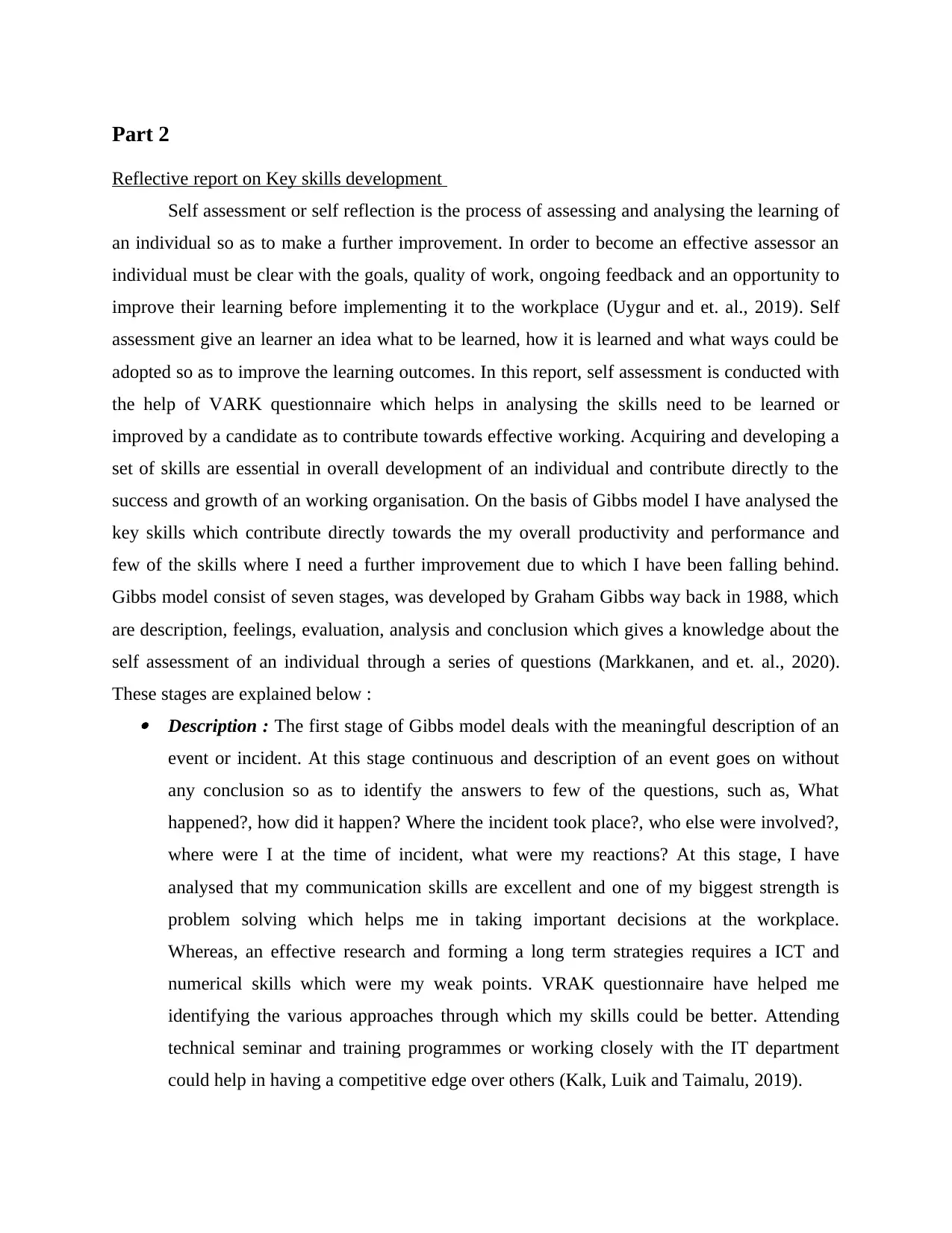
Part 2
Reflective report on Key skills development
Self assessment or self reflection is the process of assessing and analysing the learning of
an individual so as to make a further improvement. In order to become an effective assessor an
individual must be clear with the goals, quality of work, ongoing feedback and an opportunity to
improve their learning before implementing it to the workplace (Uygur and et. al., 2019). Self
assessment give an learner an idea what to be learned, how it is learned and what ways could be
adopted so as to improve the learning outcomes. In this report, self assessment is conducted with
the help of VARK questionnaire which helps in analysing the skills need to be learned or
improved by a candidate as to contribute towards effective working. Acquiring and developing a
set of skills are essential in overall development of an individual and contribute directly to the
success and growth of an working organisation. On the basis of Gibbs model I have analysed the
key skills which contribute directly towards the my overall productivity and performance and
few of the skills where I need a further improvement due to which I have been falling behind.
Gibbs model consist of seven stages, was developed by Graham Gibbs way back in 1988, which
are description, feelings, evaluation, analysis and conclusion which gives a knowledge about the
self assessment of an individual through a series of questions (Markkanen, and et. al., 2020).
These stages are explained below : Description : The first stage of Gibbs model deals with the meaningful description of an
event or incident. At this stage continuous and description of an event goes on without
any conclusion so as to identify the answers to few of the questions, such as, What
happened?, how did it happen? Where the incident took place?, who else were involved?,
where were I at the time of incident, what were my reactions? At this stage, I have
analysed that my communication skills are excellent and one of my biggest strength is
problem solving which helps me in taking important decisions at the workplace.
Whereas, an effective research and forming a long term strategies requires a ICT and
numerical skills which were my weak points. VRAK questionnaire have helped me
identifying the various approaches through which my skills could be better. Attending
technical seminar and training programmes or working closely with the IT department
could help in having a competitive edge over others (Kalk, Luik and Taimalu, 2019).
Reflective report on Key skills development
Self assessment or self reflection is the process of assessing and analysing the learning of
an individual so as to make a further improvement. In order to become an effective assessor an
individual must be clear with the goals, quality of work, ongoing feedback and an opportunity to
improve their learning before implementing it to the workplace (Uygur and et. al., 2019). Self
assessment give an learner an idea what to be learned, how it is learned and what ways could be
adopted so as to improve the learning outcomes. In this report, self assessment is conducted with
the help of VARK questionnaire which helps in analysing the skills need to be learned or
improved by a candidate as to contribute towards effective working. Acquiring and developing a
set of skills are essential in overall development of an individual and contribute directly to the
success and growth of an working organisation. On the basis of Gibbs model I have analysed the
key skills which contribute directly towards the my overall productivity and performance and
few of the skills where I need a further improvement due to which I have been falling behind.
Gibbs model consist of seven stages, was developed by Graham Gibbs way back in 1988, which
are description, feelings, evaluation, analysis and conclusion which gives a knowledge about the
self assessment of an individual through a series of questions (Markkanen, and et. al., 2020).
These stages are explained below : Description : The first stage of Gibbs model deals with the meaningful description of an
event or incident. At this stage continuous and description of an event goes on without
any conclusion so as to identify the answers to few of the questions, such as, What
happened?, how did it happen? Where the incident took place?, who else were involved?,
where were I at the time of incident, what were my reactions? At this stage, I have
analysed that my communication skills are excellent and one of my biggest strength is
problem solving which helps me in taking important decisions at the workplace.
Whereas, an effective research and forming a long term strategies requires a ICT and
numerical skills which were my weak points. VRAK questionnaire have helped me
identifying the various approaches through which my skills could be better. Attending
technical seminar and training programmes or working closely with the IT department
could help in having a competitive edge over others (Kalk, Luik and Taimalu, 2019).
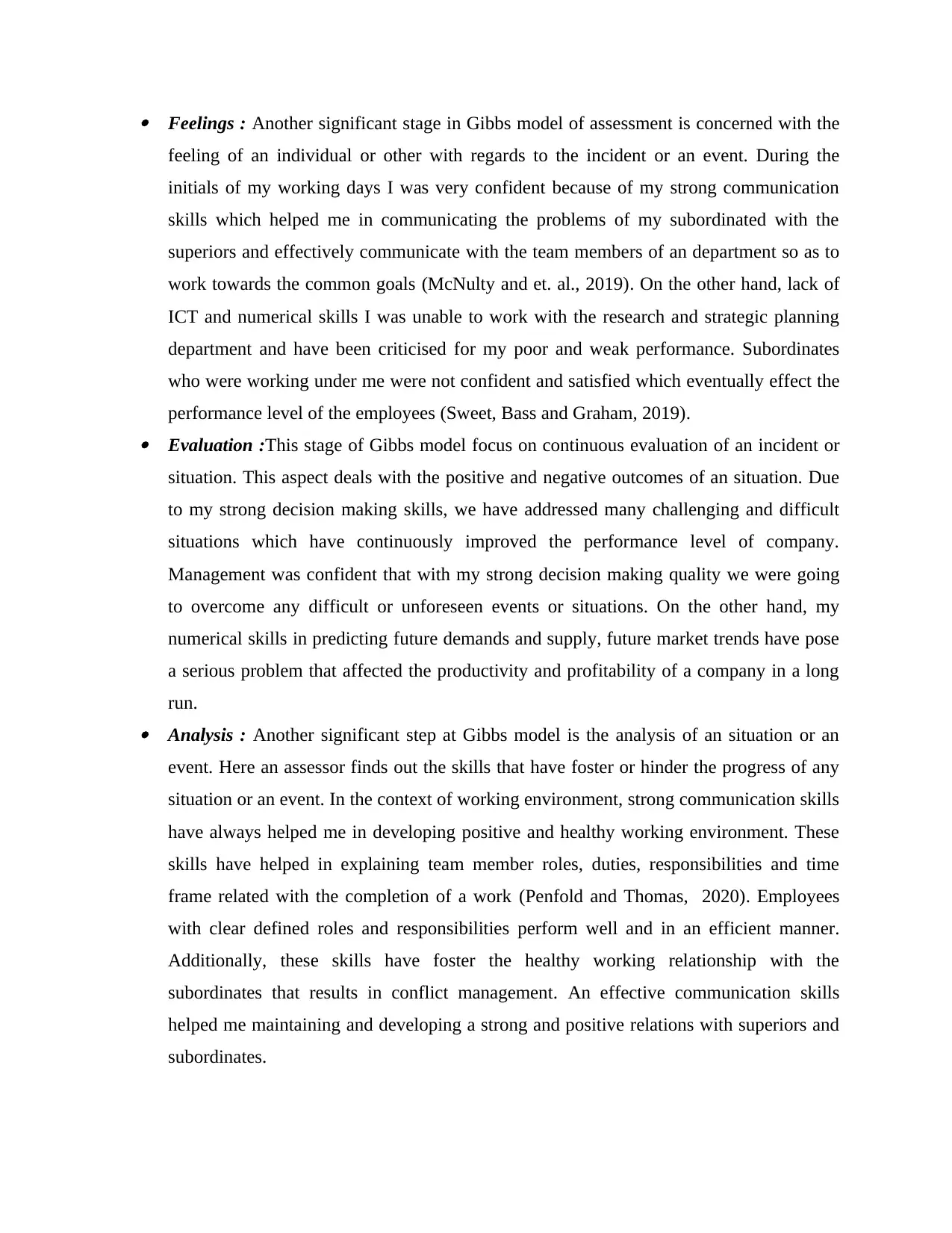
Feelings : Another significant stage in Gibbs model of assessment is concerned with the
feeling of an individual or other with regards to the incident or an event. During the
initials of my working days I was very confident because of my strong communication
skills which helped me in communicating the problems of my subordinated with the
superiors and effectively communicate with the team members of an department so as to
work towards the common goals (McNulty and et. al., 2019). On the other hand, lack of
ICT and numerical skills I was unable to work with the research and strategic planning
department and have been criticised for my poor and weak performance. Subordinates
who were working under me were not confident and satisfied which eventually effect the
performance level of the employees (Sweet, Bass and Graham, 2019). Evaluation :This stage of Gibbs model focus on continuous evaluation of an incident or
situation. This aspect deals with the positive and negative outcomes of an situation. Due
to my strong decision making skills, we have addressed many challenging and difficult
situations which have continuously improved the performance level of company.
Management was confident that with my strong decision making quality we were going
to overcome any difficult or unforeseen events or situations. On the other hand, my
numerical skills in predicting future demands and supply, future market trends have pose
a serious problem that affected the productivity and profitability of a company in a long
run. Analysis : Another significant step at Gibbs model is the analysis of an situation or an
event. Here an assessor finds out the skills that have foster or hinder the progress of any
situation or an event. In the context of working environment, strong communication skills
have always helped me in developing positive and healthy working environment. These
skills have helped in explaining team member roles, duties, responsibilities and time
frame related with the completion of a work (Penfold and Thomas, 2020). Employees
with clear defined roles and responsibilities perform well and in an efficient manner.
Additionally, these skills have foster the healthy working relationship with the
subordinates that results in conflict management. An effective communication skills
helped me maintaining and developing a strong and positive relations with superiors and
subordinates.
feeling of an individual or other with regards to the incident or an event. During the
initials of my working days I was very confident because of my strong communication
skills which helped me in communicating the problems of my subordinated with the
superiors and effectively communicate with the team members of an department so as to
work towards the common goals (McNulty and et. al., 2019). On the other hand, lack of
ICT and numerical skills I was unable to work with the research and strategic planning
department and have been criticised for my poor and weak performance. Subordinates
who were working under me were not confident and satisfied which eventually effect the
performance level of the employees (Sweet, Bass and Graham, 2019). Evaluation :This stage of Gibbs model focus on continuous evaluation of an incident or
situation. This aspect deals with the positive and negative outcomes of an situation. Due
to my strong decision making skills, we have addressed many challenging and difficult
situations which have continuously improved the performance level of company.
Management was confident that with my strong decision making quality we were going
to overcome any difficult or unforeseen events or situations. On the other hand, my
numerical skills in predicting future demands and supply, future market trends have pose
a serious problem that affected the productivity and profitability of a company in a long
run. Analysis : Another significant step at Gibbs model is the analysis of an situation or an
event. Here an assessor finds out the skills that have foster or hinder the progress of any
situation or an event. In the context of working environment, strong communication skills
have always helped me in developing positive and healthy working environment. These
skills have helped in explaining team member roles, duties, responsibilities and time
frame related with the completion of a work (Penfold and Thomas, 2020). Employees
with clear defined roles and responsibilities perform well and in an efficient manner.
Additionally, these skills have foster the healthy working relationship with the
subordinates that results in conflict management. An effective communication skills
helped me maintaining and developing a strong and positive relations with superiors and
subordinates.
⊘ This is a preview!⊘
Do you want full access?
Subscribe today to unlock all pages.

Trusted by 1+ million students worldwide
1 out of 14
Related Documents
Your All-in-One AI-Powered Toolkit for Academic Success.
+13062052269
info@desklib.com
Available 24*7 on WhatsApp / Email
![[object Object]](/_next/static/media/star-bottom.7253800d.svg)
Unlock your academic potential
Copyright © 2020–2025 A2Z Services. All Rights Reserved. Developed and managed by ZUCOL.




